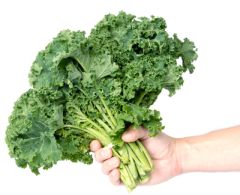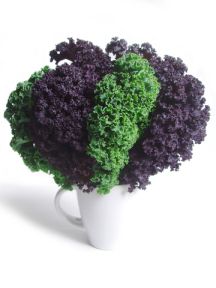- Home
- Green Smoothies
- Benefits of Kale
What is Kale? How can I eat it?
What is Kale?
We’ve all heard of broccoli and even swiss chard, but what is kale? We all know how nutritious green vegetables are for our bodies. The same old greens can sometimes get a bit boring.
Kale is a leafy green, cruciferous vegetable similar to collards, but it has added benefits not shared with other greens. An easy and delicious way of getting the recommended amount of healthy greens in your diet is by adding kale to a green smoothie. Green smoothies are packed with nutrients and are easily digested.
What is Kale's Benefits?

The benefits of kale include its high lutein and flavonoid content and lack of oxalic acid. Lutein is a cancer preventative while flavonoids protect the heart and can control blood pressure. Oxalic acid, found in most other green leafy vegetables, is unhelpful because it prevents calcium absorption. By including kale in the diet you will get the most out of the other calcium rich foods you eat as well.
Kale also provides iron, magnesium, fiber and is high in A and C vitamins. Calcium is an essential part of everyone’s diets. The calcium in kale is more readily absorbed than the calcium in other foods, including dairy.
Kale also helps regulate women’s estrogen levels and can help prevent conditions associated with hormone imbalance such as the symptoms of menopause. The benefits of kale even extend to pregnancy and breastfeeding. Kale offers folic acid to protect your baby’s growth and to stimulate milk supply.
What is Kale Stored in Best?

Kale grows at its best in fall/winter, and should be selected when the leaves are a fresh green and crisp, not yellow or wilted. Kale needs to be kept cold as it will deteriorate quickly in warm temperatures. In warmer seasons, kale can still be enjoyed if chosen while young and the leaves used raw in salads.
After buying or harvesting kale, keep it unwashed in a plastic bag in the crisper section of your refrigerator. Wrap a wet paper towel around the leaves to lengthen the freshness. The taste of kale gets stronger the longer you store it, so try to use it within a week or so.
If you want to avoid wastage and save money, it is possible to extend the life of kale by freezing it following a few simple steps. First wash and dry the kale, then place it in a plastic serving-size bag in the freezer. It will thaw quickly when you are ready to use it again. You can use the frozen kale straight away in a stir-fry or toss in with your fruit smoothie. To prepare fresh kale, wash it well, and if desired remove the middle stem of the plant, using the leaves only.
What is Kale Served with Best?
You can cook kale by steaming or water or oil sautéing in stir-fries. A benefit of kale is that it is a versatile ingredient to cook with. Like spinach, it will shrink during cooking and doesn’t take very long to cook. Kale recipes tastes great combined with rice, used in oriental dishes or added to pastas.
An even more creative way to include the benefits of kale in the diet is to make green smoothies! If you’ve never tried one of these kale recipes before, you are in for a treat! They are nourishing drinks made from green leafy vegetables and fruit.
Before you get the wrong idea... Green smoothies don’t have to taste like pond scum. A green smoothie may contain roughly 70% fruit and 30% green vegetables, resulting in a smoothie that tastes like fruit – delicious.
Green smoothies are becoming more popular as a natural health drink that can be easily included in our daily diet for an important reason. The nutrients stored in the cells of plants need to be released by rupturing the cell walls. This involves either chewing our greens thoroughly or blending them well. By blending to make a smoothie, we are ensuring we receive all the essential nutrients directly.
Unlike juices, smoothies contain the whole leaf, so you are not removing the important fiber content. Green smoothies provide a huge hit of vitamins and minerals, because the ingredients in a green smoothie are raw and well blended for easy digestion. Children will love green smoothies as well, even from a young age – however introduce new vegetables slowly to small babies as you would other foods.
Next time you’re asked 'what is kale?' you’ll be able to get others hooked onto this super food. And the best way to encourage the health of your whole family is through kale and the goodness of green smoothies.
Go from What is Kale to Home
Go from What is Kale to Veggie Nutrition
The contents are not meant to diagnose, treat, cure or prevent any disease. This website is for sharing knowledge and information from the research and experience of DaNae. She encourages you to make your own health decisions based upon your research and discussion with your own qualified professionals.